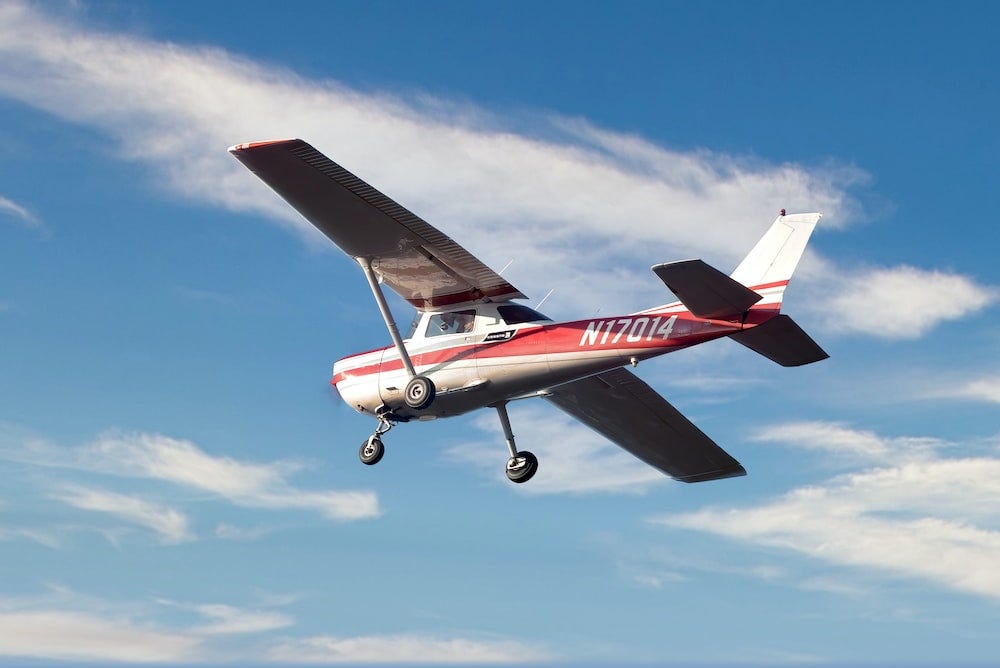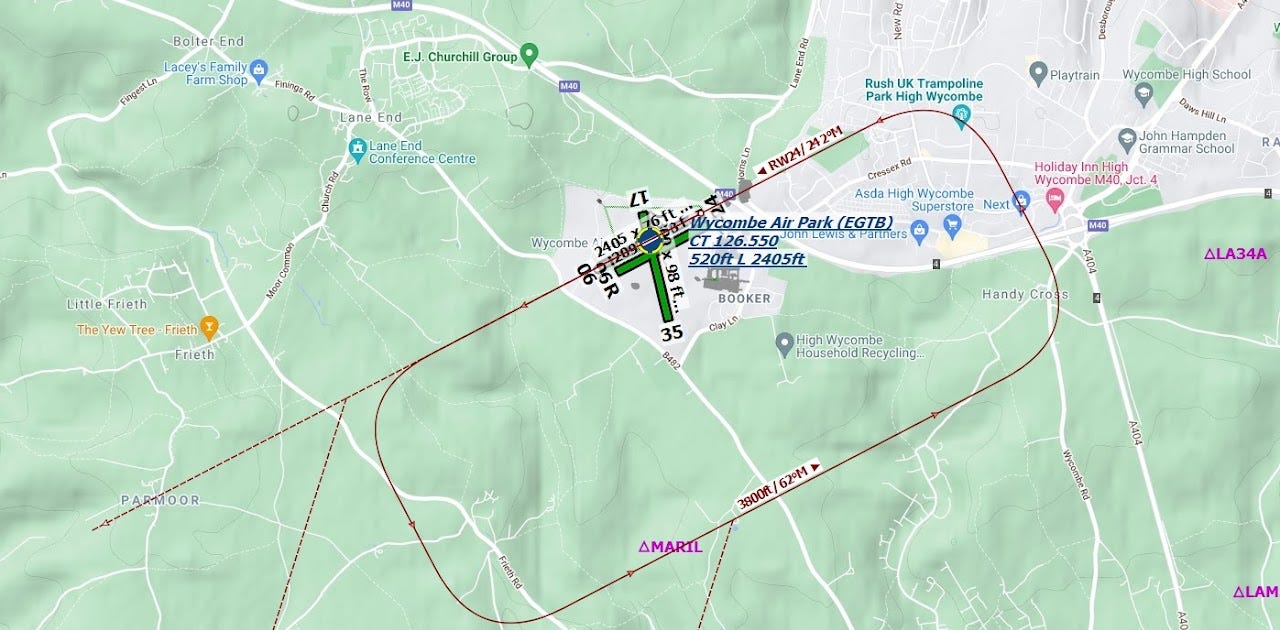Prepare to call the Tower
Those of you that have been flying with us for a while will recall some experimental events we ran in the past - giving pilots the chance to fly with staffed control towers and learn all about calling the tower, and receiving instruction.
We’re happy to announce that Roy - one of the experienced MyAir controllers - has kindly volunteered to step in and provide air traffic services on a regular basis for us.
There is of course a wider story here - if we introduce you to flying GA aircraft in controlled airspace, it’s then a small step up to flying group flights with the jets at MyAir, and an even smaller step across to VATSIM.
We appreciate that for many talking to air traffic control will be a steep learning curve. With that in mind, we are thinking about running classroom sessions too - where you will be able to learn the basics of radio telephony, and the typical conversations that happen between the tower and pilots.
Over the coming days and weeks we will run some experimental sessions, and figure out what works best. In the meantime, we have begun tidying up the Codex (the guide to all things VirtualFlight.Online) and invite you to have a read.
The rest of this week’s newsletter reflects the current guidance we have in the Codex.
ATC sessions will be advertised in Discord, along with existing events and invitations - so keep an eye out for them! Huge thanks go to Roy for putting himself forward for this.
I will start a topic in the Discord forum about Air Traffic Services - feel free to ask questions and give feedback on the idea over there!
Jonathan Beckett
Founder, VirtualFlight.Online
Getting Started with Voice Communications
Many people are intimidated by the idea of communicating with Air Traffic Control - worried about saying the wrong thing, saying something in the wrong way, or not understanding instructions. The first thing to keep in mind is Air Traffic Control is there to help you. With that in mind, over the coming days and weeks we will put together informational sections on callsigns, and example conversations.
Preparatory Reading
Some people love to read in-depth about new subjects - and ATC is something of a rabbit hole when it comes to reading material. The CAA in the UK provides a freely available radio-telephony manual, describing every facet of communication between both pilots and air traffic control. While we will not be adhering strictly to the guidelines, it provides a useful and somewhat readable reference guide.
Prerequisites
Paper & Pencil
The most valuable thing you can have in front of you when taking instruction from air traffic control is a piece of paper (or a notebook) and a pencil or pen. You can then write down instructions as they are read to you, repeat them back, and have them for future reference.
Discord
If you want to listen to and talk to others in flight, you will need to join the VirtualFlight.Online Discord server. Discord is an application you can run alongside Microsoft Flight Simulator, and provides excellent live voice-chat and screen-sharing facilities for free. Discord server membership is by invitation - visit bit.ly/virtualflightonlinediscord to get a free invite.
Configure "Push to Talk" in Discord
The ATC voice channel in Discord will enforce "push to talk" - meaning you must have a key or button mapped, which must be pushed down while talking. Push to talk results in only intended messages being communicated, and keeps the airwaves clear for other pilots.
To configure push-to-talk in Discord:
Click the cog icon next to your name at the bottom left of Discord
Click "Voice and Video" in the left margin (about half-way down)
Change the input mode to "Push to Talk", and select a key or button in the "Shortcut" box that appears.
After configuring, you will then need to hold down that key or button to talk. This helps keep channels clear, and prevents any untoward communication being broadcast too.
Transmitter
In order for Air Traffic Control to see you on radar, you will need to run a small Windows application called "Transmitter". Transmitter broadcasts your position from Microsoft Flight Simulator, such that ATC can display your position on a live map. Within the Transmitter application you can set the callsign you will be seen as by ATC.
Choose a Callsign
Within Discord, it is helpful if you change your username to reflect your callsign (so ATC know who is talking). To choose an appropriate callsign, you like with to read our guide about callsigns.
To change your name in Discord:
Click on the Server Name at the top left of Discord
Click on "Edit Server Profile"
Change your display name for the VirtualFlight.Online discord server to your callsign, followed by your name (e.g. G-JBEK Jonathan)
You can use your VirtualFlight.Online callsign if you wish - e.g. VFL0100 Jonathan (read as "Virtual 100").
Nice to Haves
LittleNavMap
LittleNavMap is a free flight planning and navigation application that runs alongside, and integrates with Flight Simulator. While you don't need a live map if using ATC, it serves as a great catch-all if you're not sure where you are.
With it you can view airfields, waypoints, and VOR stations on a map that can also display the live position of your aircraft, and those of anybody running the Transmitter application (some configuration required).
Chartfox
Chartfox provides free downloadable charts for many airports around the world (especially for the USA) - which are invaluable when communicating with ATC to both navigate around airports on the ground, and while flying circuits.
Navigraph
If you can afford a Navigraph subscription, while not essential it provides up-to-date sector and airport charts for the entire world, with a wonderful application to bring them up while in-flight with your aircraft superimposed on the printable charts. Many of the aircraft in Flight Simulator also integrate with Navigraph - allowing charts to be viewed in tablets and glass cockpit displays.
Callsigns
In order to communicate with Air Traffic Control, you will need a callsign. Given that the membership of VirtualFlight.Online come from all over the world, we thought it might be nice if people assigned themselves callsigns following the patterns of their country of origin.
Callsigns and Tail Numbers
It's worth noting that general and commercial aviation differ in terms of their callsigns:
For general aviation flight, your callsign is the registration of your aircraft (also commonly referred to as the tail number).
For commercial aviation, your callsign is your flight number.
If flying together as a group in general aviation, you might also be collectively addressed by ATC as a flight number too.
International Aircraft Registration Formats
You can lookup international tail-number formats at the following page in Wikipedia:
Examples
Here are some examples from a few countries of the world:
United Kingdom
G-ABCD (G followed by a hyphen, then four alphabetic characters).
United States
N123AB (N followed by five alpha-numeric characters - the first three of which should be numbers)
Canada
C-ABCD (C followed by a hyphen, then four alphabetic characters)
Feel free to find out the callsigns for your part of the world, and prefix your username within the VirtualFlight.Online Discord Server with yours.
Germany
D-ABCD (D followed by a hyphen, then four alphabetic characters)
Radio Telephony 101
Some guidelines to get you started with radio communication. It's worth noting - especially for VirtualFlight.Online - these are guidelines - not rules. Nobody is going to be reprimanded for not following correct etiquette, or using incorrect phraseology. You might receive constructive feedback, but it will always be in the spirit of helping improve rather than critiquing efforts.
Aviate, Navigate, Communicate
It's always worth remembering that if you're struggling to keep up with the workload of flying the aircraft, navigating, and communicating, the aircraft always comes first. If needed, a short message to ATC briefing your situation will avoid repeating calls to you - and may even result in ATC clearing airspace for you. Remember ATC is there to help you.
Don't Stand On Others
A memorable radio telephony phrase - "don't stand on others" means "don't transmit on a channel when somebody else is transmitting" - i.e. don't talk over each other. This correlates with why it is so important to use "push to talk". Always wait for somebody else's communication to complete before making your own transmission.
In an emergency, you can transmit over others - beginning your transmission with "BREAK BREAK" . This will silence all others on the channel. If you hear "BREAK BREAK" in the middle of your own transmission, stop transmitting immediately.
Always spell your callsign using the phonetic alphabet
When communicating, always spell out your callsign using the phonetic alphabet - so "Cessna G-ABCD" becomes "Cessna Golf Alpha Brave Charlie Delta".
Only abbreviate your callsign after ATC has abbreviated it
Always address air traffic control with your full callsign during first communication with them. If air traffic control responds using an abbreviated form of your callsign - which they may after a first communication - you may respond using the abbreviated callsign too. e.g. "G-ABCD may be abbreviated to "G-CD", or "Golf Charlie Delta". Be mindful of listening for both your full callsign, and the abbreviated form.
When initiating communication with ATC, lead with the target, your identity, location, and intentions
If you are initiating communication with air traffic control, begin by naming the target of your communication, followed by your aircraft type, callsign, location, and intentions - e.g. "Booker Tower, Cessna G-ABCD, ten miles south of you, heading three five zero, height two thousand feet, requesting full stop landing".
It is common during online flights to hear shortened forms of communication - e.g. "Booker Tower, Cessna G-ABCD requesting full stop landing". Shortened communication is at the discretion of ATC - at the very least they may respond with requests for further information, which you can avoid by informing fully on first transmission.
When responding to instruction from ATC, read back, and finish with your identity
If you are responding to an instruction from ATC, read the instruction back to them, and finish with your identity - e.g. "Maintain course and climb to two thousand feet, Cessna G-ABCD".
You no not need to read back informational transmissions
When ATC transmits information to you, such as the current weather at the airfield, you do not need to repeat the full transmission back to them. Read back is only strictly required for instructions - not for information. A simple response of "Copy, G-ABCD" is sufficient to let ATC know their information was received and understood.
Example Communications - Unicom
When operating general aviation aircraft away from controlled airspace, all aircraft use a shared "Unicom" channel - frequency 122.80 in VATSIM and IVAO - although in the real world it varies from location to location and is stated on flight charts. In the VirtualFlight.Online Discord server, this is the 122.80 UNICOM voice channel.
When transmitting on "Unicom", pilots announce their intentions for the benefit of nearby traffic - which provides a great excuse to practice radio telephony phraseology - even if you're alone on the channel. In turn, you can listen to the intentions of nearby traffic, and react appropriately.
General conversation should not be transmitted on the UNICOM channel.
Departure
Pilot: Booker traffic, Cessna G-ABCD engine start from parking 12, facing east
Pilot: Booker traffic, Cessna G-ABCD line up and take-off runway 24
Pilot: Booker traffic, Cessna G-ABCD airborne, climbing 1,500ft, departing to the west
Approach
Pilot: Booker traffic, Cessna G-ABCD inbound from the south west, heading 060, descending 1,500ft, entering left traffic runway 24 for full stop
Pilot: Booker traffic, Cessna G-ABCD entering downwind, runway 24
Pilot: Booker traffic, Cessna G-ABCD final approach, runway 24
Pilot: Booker traffic, Cessna G-ABCD clear of runway 24
Pilot: Booker traffic, Cessna G-ABCD taxi to parking
Touch and Go
Pilot: Booker traffic, Cessna G-ABCD inbound from the south west, heading 060, descending 1,500ft, entering left traffic runway 25 for touch-and-go
Pilot: Booker traffic, Cessna G-ABCD entering downwind, runway 24
Pilot: Booker traffic, Cessna G-ABCD final approach, runway 24
Pilot: Booker traffic, Cessna G-ABCD airborne, climbing 1,500ft, departing to the south west / entering left traffic for runway 24
Example Communications - Tower
The following examples illustrate the typical conversations that might happen between a pilot and air traffic services at an airfield. Note that these conversations are purely to illustrate typical radio telephony terminology for flight simulation purposes - they do not reflect real-world communications.
EGTB Wycombe Air Park is used for the purposes of the examples.
Departure Airport - Ground
The following transmissions illustrate the typical conversation that might happen between the pilot and air traffic control from the point of starting the engines, to taxiing out to the runway. None of this is set in stone - it's an example to give you an idea of the pattern of instructions, information, responses, and typical phraseology used.
pilot starts engine, and prepares to taxi
Pilot: Booker Ground, Cessna G-ABCD radio check, and taxi
ATC: Cessna G-CD, reading you 5 by 5, taxi to holding point runway 24 via alpha
Pilot: Taxi to holding point runway 24 via alpha, Cessna G-CD
pilot taxis to holding point, following airfield chart
Pilot: Booker Ground, Cessna G-CD at holding point runway 24
ATC: Cessna G-CD please contact Booker Tower on 123 decimal 50
Pilot: Contacting Booker Tower on 123 decimal 50, Cessna G-CD
Departure Airport - Tower
The following transmissions illustrate a typical conversation that might happen between a pilot and air traffic control from the point of being handed over to tower by ground for departure. Note that the term "take-off" is not used until the final instruction to the pilot - until then the term "departure" is used by both parties.
Pilot: Booker Tower, Cessna G-ABCD holding runway 24 for departure to the south west
ATC: Cessna G-ABCD, continue holding until further instruction
Pilot: Continue holding until further instruction, Cessna G-ABCD
time passes
ATC: Cessna G-CD, line up and wait, runway 24
Pilot: Line up and wait, runway 24, Cessna G-CD.
time passes
ATC: Cessna G-CD, cleared for immediate take-off, runway 24 for south west departure.
Pilot: Cleared for immediate take-off, runway 24 for south west departure.
time passes, as you climb out
ATC: Cessna G-CD, you are leaving my airspace, please tune Unicom, 122 decimal 80, goodbye
Pilot: Leaving your airspace, tune 122 decimal 80, Cessna G-CD, goodbye.
It is worth noting that while waiting for line-up or take-off clearance, Tower will typically inform the pilot of the current meteorological conditions (METAR). It is sufficient to respond to informational transmissions with "Copy, {Callsign}", rather than repeat them back verbatim. Only instructions need to be repeated back.
Destination Airport - Tower
The following transmissions illustrate the typical conversation that might happen between a pilot and air traffic control from the point a pilot approaches an airport to either land, or do a touch and go. Notice the pilot initiates the conversation, stating their identity, location, situation, and intentions. Also notice that when operating at a controlled airfield, the pilot does not announce the steps of their circuit to other aircraft - for that, see the section on Unicom communication.
Pilot: Booker Tower, Cessna G-ABCD with you at 1500ft, heading 30 degrees, 20 miles to your south west, for full stop landing.
Tower: Cessna G-ABCD we have you on radar, enter left circuit runway 24.
Pilot: Enter left circuit, runway 24, G-ABCD
time passes, during which aircraft navigates into circuit
as aircraft passes abeam runway apron on downwind leg...
ATC: Cessna G-CD, cleared to land runway 24. Wind is 220 at 5 knots. QNH is 2992. On landing, exit left.
Pilot: Cleared to land runway 24, copy weather, on landing exit left, Cessna G-CD
aircraft lands, and is holding at taxi-way
Pilot: Cessa G-CD, clear of runway 24, holding at exit, runway 24
ATC: Cessna G-CD, contact ground on 123 decimal 10
Pilot: Contacting ground, 123 decimal 10, Cessna G-CD
It's worth noting that ATC may issue specific instructions to approaching aircraft in order to aid in separation from other aircraft in the airspace, or to give priority to specific aircraft.
Destination Airport - Ground
The following transmissions illustrate the typical conversation that might happen between a pilot and air traffic control from the point of being handed to ground by the tower on arrival at an airport. Typically the pilot will stop at the first holding point after exiting the runway before taking further instruction from ground for routing to a suitable parking spot.
Pilot: Booker Ground, Cessna G-ABCD, at exit runway 24, requesting taxi for parking
ATC: Cessna G-ABCD, cleared to taxi via grass to general aviation parking
Pilot: cleared to taxi via grass to general aviation parking, Cessna G-ABCD
pilot refers to airfield chart, and follows taxi route to parking, and stops the aircraft
Pilot: Booker Ground, Cessna G-ABCD is on the blocks
ATC: Cessna G-ABCD, welcome to Booker... and further welcome information
Support
If you are in a position to help fund the internet machinery that makes VirtualFlight.Online possible, everybody in the community will be appreciative. As you may have noticed, we hit a speed-bump with Google Maps this week - who knew that 400 people requesting maps repeatedly would increase costs by an order of magnitude!?
Seriously though - if you can help, that would be great. We have a patreon account:








